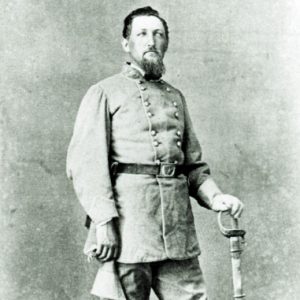calsfoundation@cals.org
Lamartine (Columbia County)
Lamartine was a small community founded in present-day northwest Columbia County sometime before 1840. Some sources credit it as being the county’s oldest community. During the Civil War, Thomas Pleasant Dockery, son of one of the earliest settlers, rose to the rank of Confederate Brigadier General.
Long before white settlers, the area was home to large numbers of Caddo. Due to the Caddo movement and trade, the area was crossed by a number of trails. These trails and eventually roads, including a military road constructed in the 1830s by the federal government, made movement by white settlers into the area easier. These roads also connected the area to the Ouachita and Red rivers. By the 1840s, a white settlement began to develop, increasing after the arrival of John Dockery and his family in about 1850. Dockery, a cotton broker from New Orleans, Louisiana, was reported to have exchanged some notes for over 1,000 acres of land and slaves in what was then Ouachita County. Upon arrival, he established a large plantation and constructed a substantial two-story brick home. By 1860, only five other county landowners possessed more slave property than he.
In 1851, just months before the settlement became a part of newly created Columbia County a post office was established. It is believed that Dockery named the settlement in honor of Alphonse Marie Louis de Prat de Lamartine, a nineteenth-century French poet and politician whom he admired. By the early 1850s, a store was being operated by a man named Filebelman. Nearby Shiloh Church, for local Baptists, was built in 1853, though the church was not actually founded until 1855. A two-story Methodist church was constructed, with the second story used for meetings by the Masons. The church was also used as a school. A Church of Christ was established in 1869.
Dockery, who had become the principal promoter of Lamartine, embarked upon his most ambitious project in 1852. On January 8, 1851, Dockery and stockholders chartered the Mississippi, Ouachita and Red River Railroad. The railroad was intended to connect the Mississippi River with the Red River, putting Lamartine in the path of a potential economic boom. Dockery served as the founding president of what is considered to be the first railroad chartered in Arkansas. The grading of the rail bed and a few miles of track were laid before the collapse of the investment in 1858. This failure is generally credited to the national economic troubles known as the Panic of 1857 and additional concerns leading to the Civil War.
Like most small settlements in antebellum Arkansas, any hopes of further development were stymied by the Civil War. Large numbers of the men of Columbia County cast their lot with the new Confederacy, joining military units organized in the area. Many of these men served in the Sixth Arkansas Infantry and the Nineteenth Arkansas Infantry among others. Before the war ended, Thomas Pleasant Dockery, son of the elder Dockery, was promoted to the rank of brigadier general. Dockery commanded troops in many of the major battles in the western theater of war and Arkansas.
When John Dockery died in 1860, the settlement lost its greatest promoter and perhaps any hopes of survival. The settlement never recovered from the war, and when the St. Louis, Arkansas and Texas Railroad bypassed it some three and one-half miles to the south in 1883, its fate was sealed. The settlement lost much of its importance when the post office was moved to the tracks approximately one year later. Residents and what little remained of the business after the war moved to Waldo (Columbia County), the new town developing along the tracks. Soon, all that remained were a handful of residents.
Today, Lamartine is a small community located on State Highway 371. Nothing remains of the nineteenth-century settlement other than two cemeteries, one being the burial site of the Dockery family. In 1936, the Arkansas Centennial Commission marked the settlement’s location with a cast-iron historical marker.
For additional information:
Deane, Ernie. “Stories of Colonel and Prolific Springs Worth Repeating.” Arkansas Gazette. October 29, 1958, p. 1B.
Jones, Mollie Cannon. “Looking Back on Lamartine.” Arkansas Gazette Magazine. November 28, 1937, p. 5.
Killgore, Nettie Hicks. History of Columbia County. Magnolia, AR: Magnolia Printing Company, 1947.
Martel, Glenn Gardner. “Early Days in Columbia County.” Master’s thesis, Henderson-Brown College, 1918.
Mike Polston
CALS Encyclopedia of Arkansas
 Columbia County Map
Columbia County Map  Thomas Dockery
Thomas Dockery 



Comments
No comments on this entry yet.